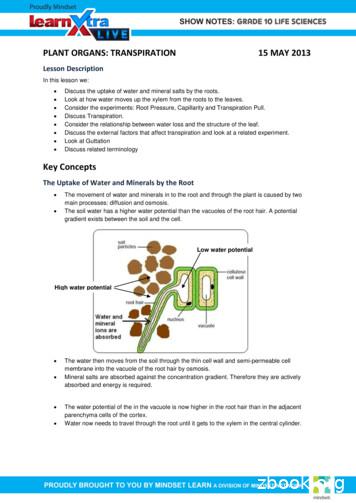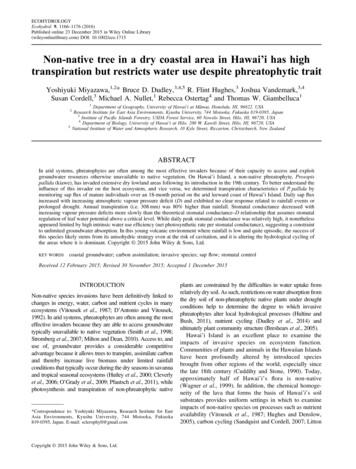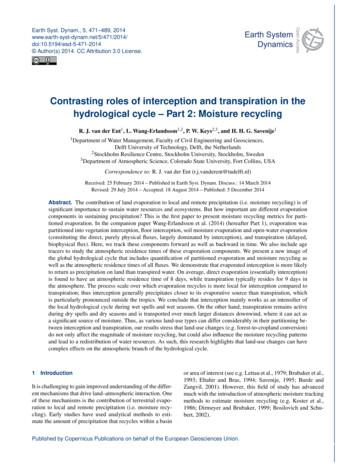TRANSPIRATION - Jiwaji University
TRANSPIRATIONBY:Dr. Madhu Gupta (Guest Faculty)SOS in BotanyJiwaji UniversityGwalior
What is it?The loss of water in the vapourform from the exposed parts of aplant is called transpiration. Theloss of water due to transpirationis quite high.Rather 98-99% of the waterabsorbed by a plant is lost intranspiration. Hardly 0.2% is usedin photosynthesis while theremaining is retained in the plantduring growth.Most of the transpiration occursthrough foliar surface or surface ofthe leaves. It is known as foliartranspiration. Foliar transpirationaccounts for over 90% of the totaltranspiration.
Transpiration occurs through young or mature stem is called as Caulinetranspiration.Depending upon the plant surface, transpiration is classifiedinto three types:StomatalTranspiration Water vapour diffuses out through minute pore(stomata) present in soft aerial part of plant is knownas Stomatal TranspirationLenticularTranspiration Sometimes water may evaporate through certainother openings present on the older stems. Theseopenings are called Lenticels and the transpirationthat takes place through term is known as LenticularTranspiration.CuticularTranspiration Loss of water may also take place through cuticle, butthe amount so lost is relatively small This type of transpiration depends upon the thicknessof the cuticle and presence or absence of wax coatingon the surface of the leaves.
Stomatal Transpiration
Lenticular Transpiration
Cuticular Transpiration
Factors Affecting Transpiration:Water Stress: Whenever the rate of transpiration exceeds the rate ofabsorption, a water deficit is created in the plants and results in the incipientwilting of leaves. The development of internal water deficit in a plant causesΨ gradient between the guard cells and the mesophyll and epidermal cellssurrounding the cells.Carbon Dioxide: Stomatal mechanism is sensitive to carbon dioxideconcentration. Stomata close in the presence of high concentrations of CO2.Oxygen: This gas is essential for the opening of stomata. Its deficiencyquickens stomatal closure.Hormones: ABA causes stomatal closure whereas cytokinins are essential forthe intake of K . Moreover, ABA works only in the presence of CO2.Light: Generally, stomata open when exposed to illumination and close in thedark. In majority of the cases, blue light absorbed by a special pigment system,affects opening.
Temperature: When all other factors are equal, stomatal openingincreases with rise in temperature up to 25 - 30 C and decreases at stillhigher temperatures.In most species stomata fail to open at or near 0 C. In some species hightemperatures of about 40 C cause stomatal opening instead of closingeven in the dark.Mineral deficiencies: With the deficiency of any of minerals such as,nitrogen, phosphorus and potassium, the stomatal movements becomesluggish. Different ions affect the stomatal aperture differently.Wind: Stomata close when the leaf is exposed to high wind velocities.This may be due to the loss of water by the guard cells duringtranspiration or the effect may be indirect through leaf temperature.Mechanical shock: Various types of shocks, such as rough handling ofleaves may result in stomatal closure. It is found that stomata may closein light when nearby tissue is wounded.
Significance:I. Transport of mineralsII. Lowering of leaf temperatureIII. Optimum turgidityIV. Bringing water to the top of a plantDisadvantagesThe conclusive fact about transpiration is that it is harmful. It is loss ofone of the essential components of life and one of the substrates of mostimportant process for the plant life- photosynthesis. It may be added thatthe existence of transpiration in plants may not be taken to mean that it isuseful to the plant body.For photosynthesis wet cell walls and open stomata are essential andthese involve transpiration. This is accomplished through diffusion. Thedanger is when the amount of diffused water exceeds the amountentering the roots, the wilting may be caused and this results in loweringthe yield or even the death of a plant.
Make Notes.Focus on the concept.Be thorough withdiagrams.Ask questions.Find answers.Thank You!
Transpiration occurs through young or mature stem is called as Cauline transpiration. Depending upon the plant surface, transpiration is classified into three types: Water vapour diffuses out through minute pore (stomata) present in soft aerial part of plant is known as Stomatal Transpiration Stomatal Transpiration
Transpiration Rates Transpiration depends on concentration gradients in the same way that mass flow does The driving force of transpiration is the "vapor pressure gradient." This is the difference in vapor pressure between the internal spaces in the leaf and the atmosphere around the leaf Factors affecting rate of transpiration
Transpiration Pull This is the main force that causes water to move up the stem against the force of gravity. Transpiration is the loss of water in the form of water vapour through the aerial parts of a plant through stomata Experiment to demonstrate that transpiration occurs through the aerial parts of a plant
Global Reference Evapo-Transpiration (Global-ET0) Potential Evapo-Transpiration (PET) is a measure of the ability of the atmosphere to remove water through Evapo-Transpiration (ET) processes. Among several equations to estimate PET, a FAO application of the Penman-Monteith equation (Allen et al. 1998), here referred as FAO-
transpiration rates increase in response to rainfall events, allowing higher transpiration rates than the level that is expected to be achieved under isohydric stomatal control (Oren et al., 1999). In this study, we monitored the sap flux of P.pallida stands with ample access to shallow groundwater and compared the annual transpiration rate .
schemes such as film and transpiration cooling will have to be utilized. Theoretically transpiration cooling is superior to film cooling as shown in reference 4, provided the oxidation problems described below can be over- come. Also good creep life can be accomplished with transpiration cooled blade
2.3.3. Transpiration rate 10 2.3.4. Soil water status 11 2.4. Theoretical Background 12 2.4.1. Determination of tree transpiration based on sap-flow measurement by the heat-pulse technique 12 2.4.2. Micro-meteorological methods for estimating transpiration of an avocado orchard 15 2.4.2.1.
transpiration; thus interception generally precipitates closer to its evaporative source than transpiration, which is particularly pronounced outside the tropics. We conclude that interception mainly works as an intensifier of the local hydrological cycle during wet spells and wet seasons. On the other hand, transpiration remains active
professor; he trades the markets every day. He has good and bad days, like any other trader, but what sets him apart is that he is a real trader. That is what makes him such a great mentor. For him to write a book is a logical next step in his passion to help make other traders successful. With almost 30 years of trading experience, the charisma of an entertainer, coupled with the professional .























